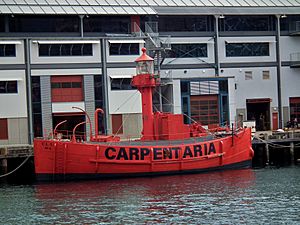CLS4 Carpentaria facts for kids

Lightship CLS4 "Carpentaria" moored at Wharf 7, Darling Harbour.
|
|
Quick facts for kids History |
|
|---|---|
| Name | Carpentaria |
| Namesake | Gulf of Carpentaria |
| Owner | Australian National Maritime Museum |
| Builder | Cockatoo Island Dockyard, Sydney, Australia |
| Laid down | 1916 |
| Completed | 1917 |
| Commissioned | 1917 |
| Decommissioned | 1985 |
| Homeport | Sydney |
| Fate | Preserved |
| Status | Museum ship as of late 2016 |
| General characteristics | |
| Type | Lightvessel |
| Displacement | 164 t (161.4 long tons; 180.8 short tons) |
| Length | 21.94 m (72.0 ft) |
| Beam | 7.82 m (25.7 ft) |
| Draft | 2.74 m (9.0 ft) |
| Propulsion | none |
| Complement | none |
| Notes | Career and characteristics data from “ANMM” website, unless noted otherwise. |
A lightship is like a floating lighthouse! The Commonwealth Lightship 4 (CLS4) Carpentaria is a special ship that helped guide other ships. It worked from 1917 to 1985 for the Commonwealth Lighthouse Service. This ship was built in 1917 at the Cockatoo Island Dockyard in Sydney. It's named after the Gulf of Carpentaria, a large bay in northern Australia. The Carpentaria spent most of its working life there, along with its sister ship, CLS2.
Contents
What is a Lightship?
A lightship is a floating lighthouse. It stays in one place to warn other ships about dangers. These dangers could be shallow waters or rocks. Lightships are used where building a lighthouse on land is too hard. They help ships navigate safely, especially at night or in bad weather.
How Carpentaria Was Built
The Carpentaria is one of four similar lightships. They were all designed in 1915 by a Scottish company. These ships were built between 1916 and 1917. The building took place at the Cockatoo Island Dockyard in Sydney, Australia. The four ships were named CLS1, CLS2, CLS3, and CLS4.
Designed for Staying Still
These lightships were made to stay anchored in one spot. They could stay offshore for a long time. This design meant they didn't need to return to port often. The Carpentaria has a strong steel body. It has no main deck structure, just a single mast. This mast held the bright light beacon.
No Engines, Just a Light
Since it stayed still, the Carpentaria had no engines to move itself. Other boats had to tow it to new locations. In 1950, a diesel engine was added. This engine was only for powering the anchor. It helped pull up the heavy anchor chain. A small steel room was built to protect this engine.
The Light and Sound
The Carpentaria's main light used acetylene gas. It carried enough gas for six months! A special valve controlled the light. It made the light flash in a unique pattern. This pattern told other ships which station the lightship was at. The light turned off during the day to save gas. Its bright beacon could be seen from 10 nautical miles away. The ship also had a bell. This bell would ring when the ship rocked. It helped guide ships when it was foggy or hard to see.
Carpentaria's Journey
The CLS4 Carpentaria was launched in 1917. It started its service that same year. It worked in the Gulf of Carpentaria with its sister ship, CLS2. They would take turns. One ship would be on duty, while the other was in port for repairs.
Guiding Ships in Bass Strait
Later in its life, the Carpentaria moved to the Bass Strait. This is a busy waterway between mainland Australia and Tasmania. The lightship helped separate ship traffic. It made sure large container ships stayed in their lanes. The Carpentaria had some close calls there. It narrowly avoided being hit by these huge ships.
A New Home in a Museum
In 1985, both Carpentaria lightships stopped working. They were saved to become museum exhibits. CLS2 went to the Queensland Maritime Museum in Brisbane. CLS4, our Carpentaria, went to the Australian National Maritime Museum in Sydney.
As of late 2016, the CLS4 Carpentaria is still at the museum. You can see it on display at the museum’s wharves in Darling Harbour. It's a great example of Australia's maritime history.

